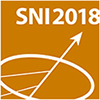Speaker
Description
Quasicrystals have a unique aperiodic order, which leads to diffraction patterns of 8-, 10-, or 12-fold rotational symmetry. They are usually found for binary and ternary metal alloys. Beginning in 2004 there have been reports on quasicrystalline structures formed by soft materials such as dendrimers, polymers and surfactants. This indicates that there might be very general principles that favor the formation of quasicrystals, and if this would be the case, they could be rationally designed with characteristic length scales up to the submicron range for photonic applications.
We have discovered quasicrystalline phases with 12- and 18-fold rotational symmetry for PI-PEO block copolymer polymer micelles in water, and for PS-PI block copolymer micelles in diethylphthalate. Their stability range and phase transitions into FCC, BCC, Frank-Kasper and disordered phases as a function of concentration, temperature and molecular weight can be well determined by rheo-SAXS and rheo-SANS experiments. Using MD-simulations we are able to map the stability regions of a large variety of crystalline (FCC, BCC, HCP, Cp4, BC8, hP2, hP10), quasi-crystalline (ldQ12, hdQ12, IQC) and Frank-Kasper phases (A15, H) in terms of the micellar volume fraction and core/shell size ratio. The phase diagram for the first time links previous reports of quasicrystals in nanoparticles, polymers and MD-simulations to provide a fundamental understanding of the structure and stability of soft quasicrystals.

